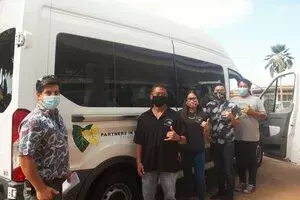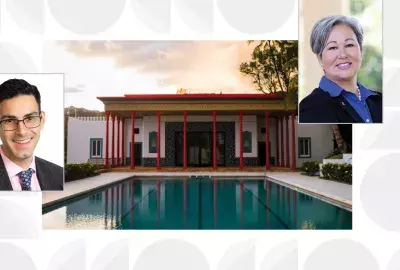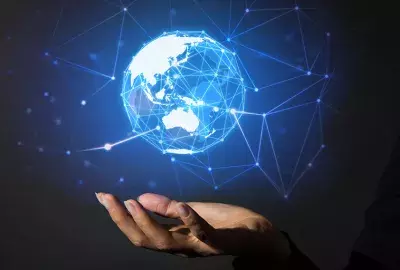Error message

A Hawai‘i collective works to ease technological inequities that have worsened in the pandemic
Quick take:
- The COVID-19 pandemic has widened an already existing digital divide in Hawai‘i.
- Native Hawaiians and Pacific Islanders, lower income households, senior citizens and those living in rural areas have been particularly impacted, mirroring national trends.
- The Broadband Hui, a statewide coalition of organizations and individuals, has been working to find innovative solutions to this complex problem.
HONOLULU (Nov. 10, 2021) -- Hawaiʻi already had a significant digital divide before COVID-19 ever arrived on its shores. In 2019, according to federal Census Bureau data, nearly 12 percent of all households statewide did not have an internet subscription. Nearly 10 percent had no internet access of any kind, including a disproportionate number of senior citizens, lower income households and those living in in rural areas. In nearly all measures relating to technology, Native Hawaiians and Pacific Islanders lagged behind the general population.
When the pandemic forced education, health care, government services, and many other facets of daily life to migrate online, the divide became a chasm. Those who lacked access to computers, internet or smart phones—or the skill sets to use them effectively—were rapidly being left behind.
This situation mirrored national trends. The November 2020 Benton Institute for Broadband & Society report Growing Healthy Digital Equity Ecosystems During COVID-19 and Beyond, for example, cited research showing that Black and Hispanic adults remain less likely to say they own a computer or have high-speed internet at home, and that Native American tribal lands are the least connected areas in the country.
‘Equity starts locally’
Early in the pandemic, a statewide Hawai‘i coalition came together to brainstorm solutions. The group, which came to be known as the Broadband Hui, has been meeting on a weekly basis since March 2020. As part of national Digital Inclusion Week, the East-West Center and the EWC-based Pacific Islands Development Program recently hosted “Digital Inclusion: Equity Starts Locally,” an online panel that highlighted the Hui’s progress, while also identifying ongoing needs.
“We all quickly learned that there are more pieces to the puzzle to make any kind of a connectivity project work than we previously realized,” said Hui founder and panel moderator Burt Lum, who is the strategy officer for the state government’s Hawai‘i Broadband Initiative. “It’s a little like having a leaky roof in your home, and then realizing that you’ve got a whole crumbling foundation. [pullquote][Before the pandemic] when unemployment was at two percent and kids were going to school, it was easy to overlook the problems with Hawaiʻi’s digital infrastructure.[/pullquote]”
Among the challenges made starkly visible was equitable education for students, whose 2020 spring break unexpectedly turned into a yearlong-plus shift to online learning. “A lot of assumptions about supporting students were built around them all having internet access,” said David Sun-Miyashiro, executive director of the Oʻahu-based nonprofit Hawaiʻi Kids Can. “Schools may have had Chromebooks to loan, but not all families had internet access, or perhaps were sharing one cell phone hotspot with multiple people in the home. And when people are losing jobs, internet becomes a luxury.”
To help with connectivity, Hawaiʻi Kids Can picked up on programs that had already rolled out in South Carolina and Texas: WIFI on Wheels, which uses buses and vans to provide free, mobile wifi on a set schedule—typically the weekday hours when area schools are in session. The Hawaiʻi initiative now operates at eleven sites on four islands; since its launch, more than 800 students and community members have accessed the program's services.
Measuring actual connectivity
The Broadband Hui discovered early on that many of the challenges were interrelated, and required multi-pronged solutions. It also quickly became apparent that information gaps were hampering the Hui’s efforts. For example, while federal census data gives a broad understanding of how many households do and don’t own computers or have access to the internet, it doesn’t capture neighborhood–by–neighborhood variations in the quality of Internet connectivity, nor does it help in understanding the unique needs of specific communities.
On Hawaiʻi Island, Brad Kaleo Bennett and the ‘Auamo Collaborative set out to better understand what areas of the Islands actually have serviceable broadband connectivity. Finding that local internet providers consider this to be proprietary information, the Collaborative recently joined with several partner organizations to begin a statewide Rural Broadband Mapping Initiative, in which surveyors will measure internet connection speeds on the ground, while also administering questionnaires.
“Anybody who has a cell phone knows the experience of going to an area and realizing that you don't have coverage where your provider says you do,” said Bennett. “So we are sending people into our rural areas to measure actual broadband connectivity, while also asking residents about their needs.” The initiative is still in its early stages, but is ultimately meant to provide a much clearer picture of broadband access and usage at the household level.
Telehealth brings new opportunities, challenges
[pullquote]“One of the few good things that came out of COVID was that everyone started doing telehealth,”[/pullquote] said Hui member Dr. Kelley Withy of the University of Hawaiʻi’s John A. Burn’s School of Medicine, which in the long run could benefit traditionally underserved communities, particularly in rural areas. According to surveys done by Withy, in 2014 only two percent of Hawaiʻi doctors were willing to consider telehealth services. As of 2020, more than 50 percent were providing these services.
Withy collaborated with health and social services professionals to establish Hawaiʻi Utelehealth, which has been funded through 2023 to provide free telehealth services to rural residents on all islands. However, even as telehealth has opened up new opportunities to reach far-flung patients, she noted, access remains uneven. To help with this, Hawaiʻi Utelehealth has been making refurbished computers available, hiring community health workers to provide hands-on training and working with the Pacific Basin Telehealth Resource Center and the Hawaiʻi State Public Library system to create spaces where people can receive instruction and attend telehealth appointments.
Keeping workers at home
When it comes to job skills, it’s difficult to measure just how much of the state’s workforce is or isn’t computer literate. But Kaala Souza, who is part of the state’s Workforce Development Council, knows from experience that Hawai‘i’s digital literacy levels are not what they need to be. “We see that while there are so many free resources online, not everyone has the skills to even fill out an online form,” he said.
As an early step in understanding the contours of Hawaiʻi’s digital literacy gap, the Workforce Development Council has been using Northstar, an online program designed by the nonprofit Literacy Minnesota, to assess and teach digital literacy. At the same time, Souza acknowledges that program has a major drawback: It’s only available to those who speak, read and understand English.
“Hawaiʻi is actually the first state to contribute to a nationwide recoding for Northstar to get language accessibility,” he said. Souza also noted that the Council is seeking other solutions to help teach computer literacy to those who are blind, deaf or have other physical challenges.
While educational workshops and data-gathering are ongoing, Souza said that ultimately online skills training is only the means to a larger end: “The aim is that you have opportunities to stay in Hawaiʻi and make a living here. If you don't have the skills, you can't play, and you're going to have to move to Washington state or Las Vegas—which I'm not against if that’s your choice. But not if you're forced to because you don't have the skills.”
Photo: WiFi on Wheels. Photo courtesy State of Hawai‘i.
A Hawai‘i collective works to ease technological inequities that have worsened in the pandemic
Quick take:
- The COVID-19 pandemic has widened an already existing digital divide in Hawai‘i.
- Native Hawaiians and Pacific Islanders, lower income households, senior citizens and those living in rural areas have been particularly impacted, mirroring national trends.
- The Broadband Hui, a statewide coalition of organizations and individuals, has been working to find innovative solutions to this complex problem.
HONOLULU (Nov. 10, 2021) -- Hawaiʻi already had a significant digital divide before COVID-19 ever arrived on its shores. In 2019, according to federal Census Bureau data, nearly 12 percent of all households statewide did not have an internet subscription. Nearly 10 percent had no internet access of any kind, including a disproportionate number of senior citizens, lower income households and those living in in rural areas. In nearly all measures relating to technology, Native Hawaiians and Pacific Islanders lagged behind the general population.
When the pandemic forced education, health care, government services, and many other facets of daily life to migrate online, the divide became a chasm. Those who lacked access to computers, internet or smart phones—or the skill sets to use them effectively—were rapidly being left behind.
This situation mirrored national trends. The November 2020 Benton Institute for Broadband & Society report Growing Healthy Digital Equity Ecosystems During COVID-19 and Beyond, for example, cited research showing that Black and Hispanic adults remain less likely to say they own a computer or have high-speed internet at home, and that Native American tribal lands are the least connected areas in the country.
‘Equity starts locally’
Early in the pandemic, a statewide Hawai‘i coalition came together to brainstorm solutions. The group, which came to be known as the Broadband Hui, has been meeting on a weekly basis since March 2020. As part of national Digital Inclusion Week, the East-West Center and the EWC-based Pacific Islands Development Program recently hosted “Digital Inclusion: Equity Starts Locally,” an online panel that highlighted the Hui’s progress, while also identifying ongoing needs.
“We all quickly learned that there are more pieces to the puzzle to make any kind of a connectivity project work than we previously realized,” said Hui founder and panel moderator Burt Lum, who is the strategy officer for the state government’s Hawai‘i Broadband Initiative. “It’s a little like having a leaky roof in your home, and then realizing that you’ve got a whole crumbling foundation. [pullquote][Before the pandemic] when unemployment was at two percent and kids were going to school, it was easy to overlook the problems with Hawaiʻi’s digital infrastructure.[/pullquote]”
Among the challenges made starkly visible was equitable education for students, whose 2020 spring break unexpectedly turned into a yearlong-plus shift to online learning. “A lot of assumptions about supporting students were built around them all having internet access,” said David Sun-Miyashiro, executive director of the Oʻahu-based nonprofit Hawaiʻi Kids Can. “Schools may have had Chromebooks to loan, but not all families had internet access, or perhaps were sharing one cell phone hotspot with multiple people in the home. And when people are losing jobs, internet becomes a luxury.”
To help with connectivity, Hawaiʻi Kids Can picked up on programs that had already rolled out in South Carolina and Texas: WIFI on Wheels, which uses buses and vans to provide free, mobile wifi on a set schedule—typically the weekday hours when area schools are in session. The Hawaiʻi initiative now operates at eleven sites on four islands; since its launch, more than 800 students and community members have accessed the program's services.
Measuring actual connectivity
The Broadband Hui discovered early on that many of the challenges were interrelated, and required multi-pronged solutions. It also quickly became apparent that information gaps were hampering the Hui’s efforts. For example, while federal census data gives a broad understanding of how many households do and don’t own computers or have access to the internet, it doesn’t capture neighborhood–by–neighborhood variations in the quality of Internet connectivity, nor does it help in understanding the unique needs of specific communities.
On Hawaiʻi Island, Brad Kaleo Bennett and the ‘Auamo Collaborative set out to better understand what areas of the Islands actually have serviceable broadband connectivity. Finding that local internet providers consider this to be proprietary information, the Collaborative recently joined with several partner organizations to begin a statewide Rural Broadband Mapping Initiative, in which surveyors will measure internet connection speeds on the ground, while also administering questionnaires.
“Anybody who has a cell phone knows the experience of going to an area and realizing that you don't have coverage where your provider says you do,” said Bennett. “So we are sending people into our rural areas to measure actual broadband connectivity, while also asking residents about their needs.” The initiative is still in its early stages, but is ultimately meant to provide a much clearer picture of broadband access and usage at the household level.
Telehealth brings new opportunities, challenges
[pullquote]“One of the few good things that came out of COVID was that everyone started doing telehealth,”[/pullquote] said Hui member Dr. Kelley Withy of the University of Hawaiʻi’s John A. Burn’s School of Medicine, which in the long run could benefit traditionally underserved communities, particularly in rural areas. According to surveys done by Withy, in 2014 only two percent of Hawaiʻi doctors were willing to consider telehealth services. As of 2020, more than 50 percent were providing these services.
Withy collaborated with health and social services professionals to establish Hawaiʻi Utelehealth, which has been funded through 2023 to provide free telehealth services to rural residents on all islands. However, even as telehealth has opened up new opportunities to reach far-flung patients, she noted, access remains uneven. To help with this, Hawaiʻi Utelehealth has been making refurbished computers available, hiring community health workers to provide hands-on training and working with the Pacific Basin Telehealth Resource Center and the Hawaiʻi State Public Library system to create spaces where people can receive instruction and attend telehealth appointments.
Keeping workers at home
When it comes to job skills, it’s difficult to measure just how much of the state’s workforce is or isn’t computer literate. But Kaala Souza, who is part of the state’s Workforce Development Council, knows from experience that Hawai‘i’s digital literacy levels are not what they need to be. “We see that while there are so many free resources online, not everyone has the skills to even fill out an online form,” he said.
As an early step in understanding the contours of Hawaiʻi’s digital literacy gap, the Workforce Development Council has been using Northstar, an online program designed by the nonprofit Literacy Minnesota, to assess and teach digital literacy. At the same time, Souza acknowledges that program has a major drawback: It’s only available to those who speak, read and understand English.
“Hawaiʻi is actually the first state to contribute to a nationwide recoding for Northstar to get language accessibility,” he said. Souza also noted that the Council is seeking other solutions to help teach computer literacy to those who are blind, deaf or have other physical challenges.
While educational workshops and data-gathering are ongoing, Souza said that ultimately online skills training is only the means to a larger end: “The aim is that you have opportunities to stay in Hawaiʻi and make a living here. If you don't have the skills, you can't play, and you're going to have to move to Washington state or Las Vegas—which I'm not against if that’s your choice. But not if you're forced to because you don't have the skills.”
Photo: WiFi on Wheels. Photo courtesy State of Hawai‘i.
East-West Wire
News, Commentary, and Analysis
The East-West Wire is a news, commentary, and analysis service provided by the East-West Center in Honolulu. Any part or all of the Wire content may be used by media with attribution to the East-West Center or the person quoted. To receive East-West Center Wire media releases via email, subscribe here.
For links to all East-West Center media programs, fellowships and services, see www.eastwestcenter.org/journalists.







